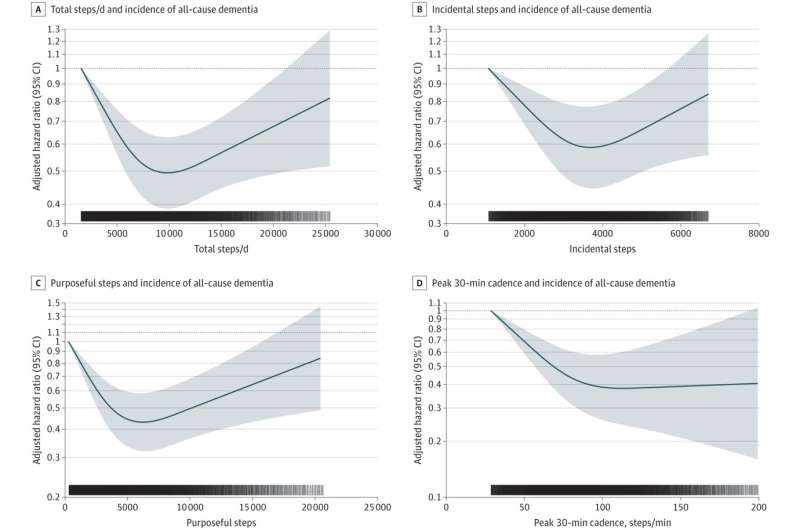Dose-response association between different accelerometer-measured step-based metrics and incidence of all-cause dementia. Shading indicates 95% CIs; solid lines, hazard ratios, in logarithmic scale, adjusted for age, sex, race, education, Townsend deprivation index, smoking, alcohol use, fruit and vegetable consumption, family history of cardiovascular disease and cancer, medication use (cholesterol, insulin, and hypertension), accelerometer-measured sleep, and days wearing accelerometer. For incidental steps, models were further adjusted for purposeful steps (and vice versa). For peak 30-minute steps, models were additionally adjusted for total steps per day. Total steps per day indicates the mean number of steps accumulated in a day; incidental steps, the total daily steps at 1-39 steps per minute; purposeful steps, the total daily steps at ≥40 steps per minute; peak 30-minute cadence, the mean steps per minute recorded for the 30 highest, not necessarily consecutive, minutes in a day. Dose-response associations were assessed with restricted cubic splines with knots at 10th, 50th, and 90th centiles of the distribution of the exposure of interest. Credit: JAMA Neurology (2022). DOI: 10.1001/jamaneurol.2022.2672
Two studies, published in JAMA Internal Medicine and JAMA Neurology, monitored 78,500 adults with wearable trackers—making these the largest studies to objectively track step count in relation to health outcomes.
The researchers from the University of Sydney, Australia and University of Southern Denmark found lowered risk of dementia, heart disease, cancer and death are associated with achieving 10,000 steps a day. However, a faster stepping pace like a power walk showed benefits above and beyond the number of steps achieved.
"The take-home message here is that for protective health benefits people could not only ideally aim for 10,000 steps a day but also aim to walk faster," said co-lead author Dr. Matthew Ahmadi, Research Fellow at the University of Sydney's Charles Perkins Centre and Faculty of Medicine and Health.
"For less active individuals, our study also demonstrates that as low as 3,800 steps a day can cut the risk of dementia by 25 percent," said co-lead author Associate Professor Borja del Pozo Cruz from the University of Southern Denmark and senior researcher in health at the University of Cadiz.
Key points:
- Every 2,000 steps lowered risk of premature death incrementally by 8 to 11 percent, up to approximately 10,000 steps a day.
- Similar associations were seen for cardiovascular disease and cancer incidence.
- A higher number of steps per day was associated with a lower risk of all-cause dementia
- 9,800 steps was the optimal dose linked to lower risk of dementia by 50 percent, however risk was reduced by 25 percent at as low as 3,800 steps a day
- Stepping intensity or a faster pace showed beneficial associations for all outcomes (dementia, heart disease, cancer and death) over and above total daily steps.
"Step count is easily understood and widely used by the public to track activity levels thanks to the growing popularity of fitness trackers and apps, but rarely do people think about the pace of their steps," said senior author Emmanuel Stamatakis, Professor of Physical Activity, Lifestyle and Population Health at the University of Sydney.
"Findings from these studies could inform the first formal step-based physical activity guidelines and help develop effective public health programs aimed at preventing chronic disease."
How was the study conducted?
The study drew on data from UK Biobank to link up step count data from 78,500 UK adults aged 40 to 79 years with health outcomes 7 years on. Participants wore a wrist accelerometer to measure physical activity over a period of 7 days (minimum 3 days, including a weekend day and monitoring during sleep periods).
With ethics consent, this information was linked with participants' health records through several data sources and registries including inpatient hospital, primary care records, and cancer and death registries.
Only those who were free of cardiovascular disease, cancer or dementia at baseline and disease-free in the first two years of the study were included in the final assessment. Statistical adjustments were also made for confounders, such as the fact that people who do more steps generally walk faster.
The researchers note that the studies are observational, meaning they cannot show direct cause and effect, however, note the strong and consistent associations seen across both studies at the population level.
"The size and scope of these studies using wrist-worn trackers makes it the most robust evidence to date suggesting that 10,000 steps a day is the sweet spot for health benefits and walking faster is associated with additional benefits," said Dr. Matthew Ahmadi.
"Going forward more research with longer-term use of trackers will shed more light on the health benefits associated with certain levels and intensity of daily stepping."
More information: Matthew Ahmadi et al, Prospective Associations of Daily Step Counts and Intensity with Cancer and Cardiovascular Disease Incidence and Mortality and All-cause Mortality, JAMA Internal Medicine (2022). DOI: 10.1001/jamainternmed.2022.4000
Borja del Pozo Cruz et al, Association of Daily Step Count and Intensity With Incident Dementia in 78 430 Adults Living in the UK, JAMA Neurology (2022). DOI: 10.1001/jamaneurol.2022.2672
Journal information: JAMA Internal Medicine , Archives of Neurology
Provided by University of Sydney
























